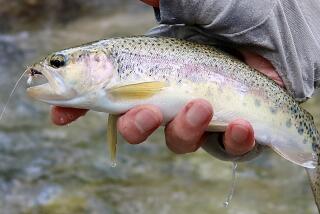Outdoors : NOTES : Albacore Still Remain in Southland, but Not Always Easy to Locate
It may be winter, but that’s not keeping albacore out of Southland waters.
Commercial fishing boats have been hauling in impressive catches of the popular tuna off the east end of Santa Rosa Island, prompting some interest in the sportfishing community, which usually waits eagerly for the fish’s showing off Baja California in the early summer.
The Outer Limits, a sportfisher out of L.A. Harbor Sportfishing, made an exploratory trip to the island last weekend but returned without any albacore.
“The wind kicked up, and we really didn’t get to look around as much as we would have liked,” said Gary Norby, the boat’s skipper. “There were a lot of birds and bait, and we had meter readings--everything looked like it was right, but for some reason we never did get any bites.”
R. Michael Laurs, an oceanographer with the National Marine Fisheries Service who specializes in migratory species, said the larger albacore, particularly this late in the season, tend to remain in deeper water, and because they are visual feeders they might not see a trolled lure or fly-lined anchovy.
Last January, commercial fishermen netted more than 700 bluefin tuna, between six and nine feet long and weighing between 300 and 1,009 pounds, in the same area. Laurs couldn’t explain what attraction those waters might hold for tuna.
Norby said he couldn’t be certain if the fish he metered were indeed albacore. But apparently the longfins are somewhere off the island’s east end. In recent weeks, commercial fishermen have reported netting eight tons of albacore, all in the 60-pound range--catches Laurs called unusual but not rare.
“Oftentimes when fish are really late in migrating into the coast (as they were this summer), you see particularly larger fish late in the season,” he said. “And the drift-net boats, when they were operating down here more, used to catch very large fish, sometimes into early January.”
Large albacore have cooperated with recreational fishermen late in the season before. In November 1984, the powerful tuna showed up between the mainland and Santa Catalina Island, and several were caught. Three of those fish, all weighing more than 70 pounds, are current line-class world records.
“Basically, the idea (behind such wintertime runs) is that almost every fish you might catch, depending on what size line you are using, could be a possible world-record fish,” Norby said. “And that kind of excites a lot of people.”
Norby said he wants to give it another try but will monitor conditions and further commercial activity first.
Meanwhile, there have been reports of a few albacore in the 12-pound class taken 72 miles south of Point Loma, including one Saturday by the Prowler, out of Fisherman’s Landing in San Diego.
Laurs said there is strong evidence that some albacore winter in the Guadalupe Island area--about 200 miles south of San Diego--to spawn, so such insignificant catches are not considered unusual.
Briefly
The 7 1/2-square-mile San Jacinto Wildlife Area east of Lake Perris will start receiving reclaimed water from Riverside County’s Eastern Municipal Water District today. The water is being piped 10 miles from a sewage treatment plant in San Jacinto. The $5.3-million project, which involves the cooperation of the EMWD, the Department of Fish and Game and the Wildlife Conservation Board, will enhance ponds for waterfowl and irrigate wildlife habitat.
Several streams in Sonoma, Mendocino, Napa and Marin counties have been closed by the Department of Fish and Game to winter fishing, on a week-to-week basis, because of low river flows. The closures--intended to protect spawning coho salmon and steelhead trout--include the Gualala River in Sonoma County, Lagunitas and Walker creeks in Marin County, the Little and Big rivers in Mendocino County, and the Napa River from Napa to Calistoga.
Phil Ershler, 38, of Bellevue, Wash., is the latest of about a half-dozen climbers to complete the Seven Summits--the highest peak on each of the seven continents. He started with the highest, 29,028-foot Mt. Everest, in 1984 and ended with a relatively modest hike to the top of 7,130-foot Mt. Kosciusko in Australia on Dec. 22. . . .The Truckee Lions’ Sierra Sweepstakes sled dog races have been postponed from this weekend to Feb. 17-18 because of current poor snow conditions.
“Hunter’s Rights in an Ever-Changing Society” is the theme of a Safari Club International symposium on Feb. 10 from 8 a.m. to 6 p.m. at the Pickwick Banquet Center in Burbank. Cost: $35 with lunch, $12 without, and reservations are required. Details: (818) 351-0700. . . .Remington is adding .22-250 and .338 calibers to its five left-handed versions of the Model 700 bolt action rifle. SaltWater Sportsman magazine’s National Seminar Series, an eight-stop tour featuring saltwater sportfishing techniques by prominent outdoor reporters and fishermen, will make its Southland stop at the Elks’ Lodge Amphitheater in Long Beach on Feb. 10 from 9 a.m. to 4 p.m. Cost: $30. Registration information: (800) 448-7360.
Fly fishing: Milt Huber will present a show on fishing the backcountry of the Sierra at the Pasadena Casting Club’s Thursday night meeting at the Masonic Temple in Pasadena, starting at 7:30. Information: (818) 845-7119.
More to Read
Sign up for Essential California
The most important California stories and recommendations in your inbox every morning.
You may occasionally receive promotional content from the Los Angeles Times.










